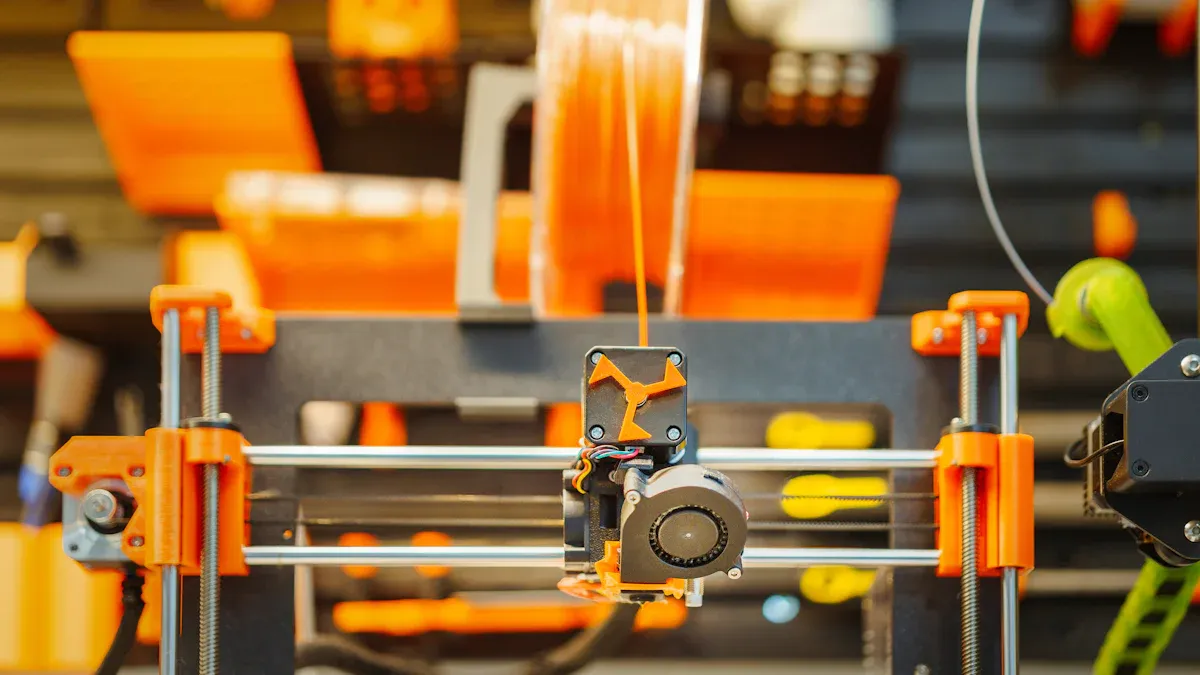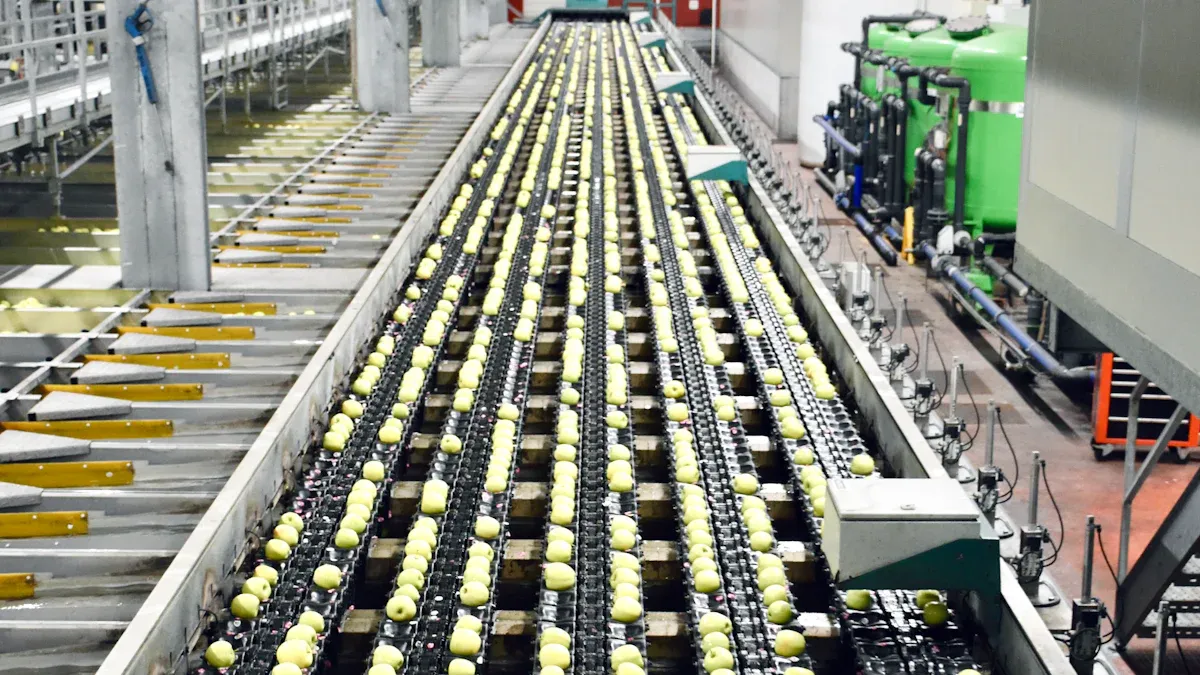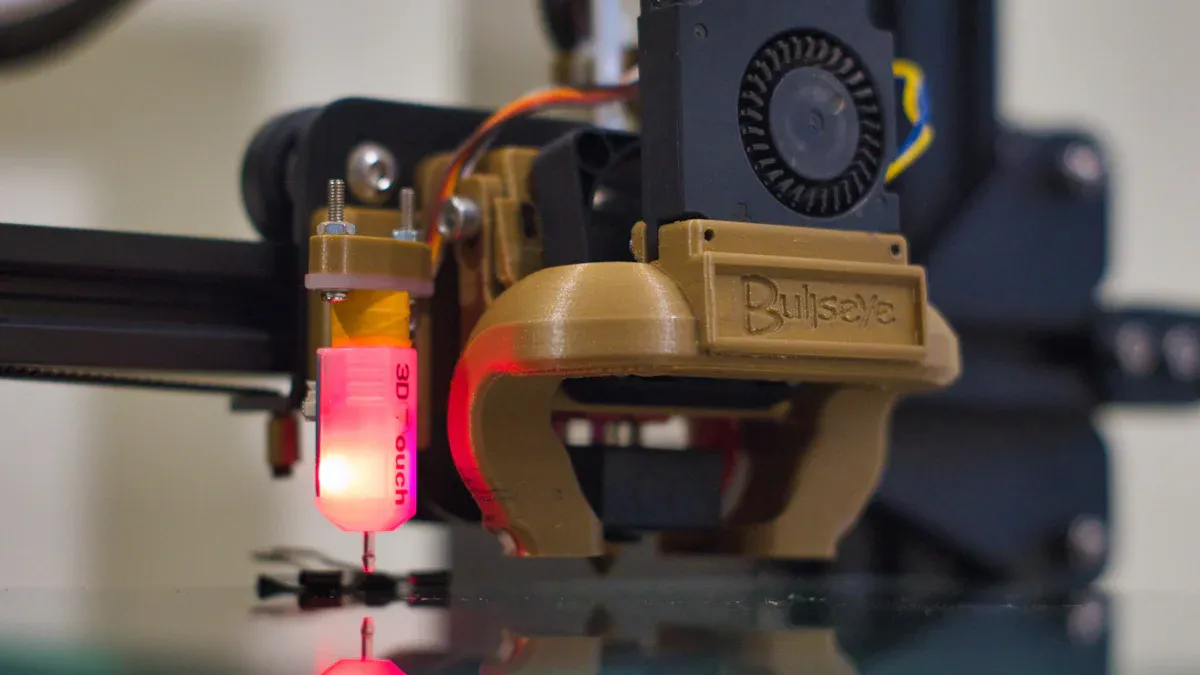
Twin screw extruders play a pivotal role in modern manufacturing by ensuring efficient and cost-effective production processes. Their advanced design enables manufacturers to achieve high-volume outputs while minimizing waste and energy consumption.
- The global twin screw extruder market reached USD 1,128.1 million in 2022.
- It is forecasted to grow to USD 1,649.5 million by 2031.
- The market is expanding at a steady CAGR of 4.5%, highlighting their increasing demand.
These machines, including twin screw compounding machines and twin screw extrusion lines, offer unmatched durability and adaptability, making them indispensable for industries worldwide. Additionally, tube extrusion machines further enhance production capabilities, solidifying the importance of twin screw technology in the manufacturing sector.
Understanding Twin Screw Extruders

What Are Twin Screw Extruders?
Twin screw extruders are advanced machines designed for the continuous processing of materials. They consist of two intermeshing screws housed within a barrel. These screws rotate to convey, mix, and process materials efficiently. The structural components include a mainframe, distribution gearbox, lubrication system, cooling water system, vacuum system, and feeding system. The screws are crafted from durable materials like nitriding steel, ensuring long-term performance. Barrels are designed for easy replacement and maintenance, which enhances operational efficiency.
The design of twin screw extruders ensures precise axial and radial clearances. This precision improves processing quality and reduces material waste. Additionally, the machines can accommodate multiple feeding positions, making them suitable for handling materials in various states. Their adaptability and robust construction make them a cornerstone of modern manufacturing.
How Do Twin Screw Extruders Work?
Twin screw extruders operate through a combination of mechanical and thermal processes. The screws rotate within the barrel to convey, mix, melt, and homogenize materials. Each component plays a critical role in achieving efficient processing.
| Component | Function |
|---|---|
| Barrel and Screws | Rotate to convey, mix, melt, and homogenize materials; designed for specific processing needs. |
| Drive System | Powers and controls screw rotation, ensuring efficiency and quality in the extrusion process. |
| Gearbox | Adjusts screw speed differentials, influencing shear, mixing, and kneading actions. |
| Control and Monitoring | Allows monitoring and adjustment of parameters like screw speed and temperature profiles. |
The adjustable feeding systems enable precise control over material input, ensuring consistent output quality. Advanced control systems monitor parameters such as screw speed and temperature, allowing operators to fine-tune the process. This level of control ensures optimal performance and minimizes energy consumption.
Key Applications in Manufacturing
Twin screw extruders are versatile machines used across various industries. In the plastics sector, they are essential for producing high-quality products like pipes, films, and profiles. The pharmaceutical industry relies on these machines for continuous wet granulation, mixing wet gelatin mass, and creating amorphous solid dispersions to improve drug solubility. They also play a vital role in loading drugs into polymers for drug-delivery devices.
| Application | Market Size (2025) | CAGR (%) |
|---|---|---|
| Plastic Products | XX Million | XX% |
| Food & Feed Extrusion | XX Million | XX% |
| Pharmaceuticals | XX Million | XX% |
The adaptability of twin screw extruders allows manufacturers to use the same equipment for research and production. This scalability makes them an ideal choice for industries requiring both flexibility and efficiency. Their ability to handle diverse materials and processes ensures their continued relevance in modern manufacturing.
Cost-Effectiveness of Twin Screw Extruders
Energy Efficiency and Reduced Waste
Twin screw extruders excel in energy efficiency, making them a cost-effective solution for manufacturers. Their advanced design minimizes energy consumption by optimizing the mechanical and thermal processes involved in material extrusion. The intermeshing screws ensure consistent material flow, reducing the need for excessive energy input. Additionally, the precise control systems allow operators to fine-tune parameters like temperature and screw speed, further enhancing energy savings.
Waste reduction is another significant advantage. The efficient mixing and homogenization capabilities of twin screw extruders ensure minimal material loss during processing. By maintaining consistent output quality, these machines reduce the need for rework or scrap, saving both time and resources. Industries that prioritize sustainability benefit greatly from this feature, as it aligns with their environmental goals while cutting operational costs.
Tip: Investing in energy-efficient equipment like twin screw extruders not only lowers utility bills but also contributes to a greener manufacturing process.
Long-Term Durability and ROI
The robust construction of twin screw extruders ensures long-term durability, making them a reliable choice for high-volume production. Components such as screws and barrels are crafted from high-strength materials like nitriding steel, which withstands wear and tear over extended periods. Advanced manufacturing techniques, including quenching and nitriding, enhance the longevity of these parts, reducing the frequency of replacements.
This durability translates into a high return on investment (ROI). Manufacturers benefit from reduced maintenance costs and minimal downtime, which directly impacts productivity. Over time, the initial investment in a twin screw extruder pays off through consistent performance and lower operational expenses. Companies seeking to maximize their ROI often choose these machines for their proven reliability and cost-effectiveness.
Modular Design for Versatility
The modular design of twin screw extruders offers unparalleled versatility, allowing manufacturers to adapt the equipment to various production needs. These machines can be customized with interchangeable screws, barrels, and other components to handle different materials and processes. This flexibility makes them suitable for a wide range of applications, from plastics and pharmaceuticals to food and feed production.
Manufacturers can also scale their operations efficiently with modular twin screw extruders. By upgrading specific components or adding auxiliary systems, they can increase production capacity without replacing the entire machine. This adaptability not only reduces capital expenditure but also ensures that the equipment remains relevant as production demands evolve.
Note: Modular twin screw extruders are an excellent choice for businesses looking to future-proof their manufacturing processes.
High-Volume Production with Twin Screw Extruders

Co-Rotating Screw Technology
Co-rotating screw technology enhances the efficiency of twin screw extruders by optimizing material flow and mixing. This design ensures consistent shear and heat distribution, which is critical for high-volume production. The screws rotate in the same direction, creating a self-wiping effect that prevents material buildup and improves processing efficiency.
| Factor | Description |
|---|---|
| Pressure Management | Elevated pressures can lead to higher overflight leakage, affecting melt temperature and potential degradation. |
| Screw Design | The selection of screws influences the pressure gradient and overall efficiency of the extrusion process. |
| Operational Parameters | Factors such as residence time, surface area, and vacuum levels significantly impact devolatilization efficiencies. |
This technology supports output rates of up to 1800 kg/hr (4000 lb/hr), making it ideal for industries requiring large-scale production. Its ability to handle diverse materials with precision ensures consistent quality and reduced waste.
Advanced Control Systems
Advanced control systems play a pivotal role in optimizing the performance of twin screw extruders. These systems monitor and adjust critical parameters such as temperature, screw speed, and material flow in real-time. The implementation of neuron-PID control algorithms for barrel temperature has significantly improved accuracy and reduced overshoot.
| Feature | Current Extruder | Similar Designs |
|---|---|---|
| Ink Viscosity | High | Low |
| Extruding Volumes | Variable | Fixed |
| Retraction Control | Advanced | Basic |
| Cost | Competitive | Higher |
The PSO-neuron-PID controller further enhances operational efficiency by mitigating heating coupling effects. These innovations ensure consistent output quality and energy savings, making twin screw extruders a reliable choice for high-volume manufacturing.
Scalability for Large-Scale Manufacturing
Twin screw extruders offer unmatched scalability, enabling manufacturers to meet growing production demands. Their modular design allows for easy upgrades and customization, ensuring seamless adaptation to increased capacity requirements.
- Medical Tube Extrusion Excellence: A European medical supplies company utilized a customized twin screw extruder to enhance production efficiency and precision for PVC medical tubing.
- Empowering New Entrants with Turnkey Solutions: A new manufacturer leveraged tailored equipment to scale operations effectively, meeting market demands with ease.
These success stories highlight the versatility and reliability of twin screw extruders in large-scale manufacturing. Their ability to deliver consistent performance across various applications ensures long-term value for businesses.
Choosing and Maintaining Twin Screw Extruders
Factors to Consider When Selecting an Extruder
Selecting the right twin screw extruder requires careful evaluation of several factors. Manufacturers should first assess the material type and processing requirements. For example, abrasive or heat-sensitive materials may demand specific screw designs or barrel coatings. Production capacity is another critical consideration. Machines with higher throughput capabilities suit large-scale operations, while smaller models may suffice for research or niche applications.
The extruder’s modularity also plays a vital role. Customizable components, such as screws and barrels, allow manufacturers to adapt the machine for various processes. Advanced control systems enhance precision and efficiency, making them indispensable for industries requiring consistent quality. Additionally, the reputation of the manufacturer and the availability of after-sales support should not be overlooked. Companies like Zhejiang Jinteng Machinery Manufacturing Co., Ltd. offer robust designs and reliable customer service, ensuring long-term value.
Routine Maintenance Practices
Routine maintenance ensures the longevity and efficiency of twin screw extruders. Key practices include:
- Conducting vibration tests on gearboxes every six to 12 months to detect potential issues.
- Using thermal imaging cameras to monitor heating and cooling systems for irregularities.
- Inspecting barrels and screws for wear and replacing or rebuilding them as needed.
- Changing gearbox oil regularly and analyzing it to prevent catastrophic failures.
These practices reduce emergency repairs and minimize downtime. Maintaining detailed records of inspections and repairs helps identify patterns and predict future maintenance needs. Proactive care not only extends the machine’s lifespan but also ensures consistent production quality.
Troubleshooting Common Issues
Operational challenges can arise even with well-maintained extruders. Monitoring specific throughput helps optimize the degree of fill, ensuring efficient operation for new products. Specific energy measurements reveal power usage per kilogram of material, aiding in identifying energy inefficiencies.
Wear on screws and barrels is a common issue caused by abrasive materials, poor alignment, or thermal expansion. Regularly measuring the barrel’s inside diameter and ensuring proper alignment can mitigate these problems. Keeping a spare screw on hand minimizes downtime during replacements. Addressing these issues promptly prevents further damage and maintains optimal performance.
Tip: Proactive monitoring and timely interventions are essential for avoiding costly repairs and ensuring uninterrupted production.
Twin screw extruders deliver unmatched benefits for cost-effective, high-volume production. Their advanced design ensures improved mixing, higher capacity, and broader material processing. These machines also enhance product quality and energy efficiency while maintaining precise process control.
| Advantage | Description |
|---|---|
| Improved Mixing | Enhances uniformity of material distribution and control over the mixing process. |
| Higher Production Capacity | Achieves higher throughput compared to single screw extruders, beneficial for larger applications. |
| Broader Processing Range | Capable of processing a variety of materials, including those with high viscosity and special treatments. |
| Enhanced Product Quality | Steady mixing and extruding improve product quality, crucial for compounding and masterbatch production. |
| Improved Energy Efficiency | Maximizes energy use and minimizes shear stress, leading to long-term cost savings. |
| Improved Process Control | Maintains process parameters within set levels for optimal results in extruded parts. |
Proper selection and maintenance of a twin screw extruder ensure long-term reliability and efficiency. Investing in high-quality solutions guarantees consistent performance, making it a valuable asset for modern manufacturing.
FAQ
What materials can twin screw extruders process?
Twin screw extruders handle plastics, rubber, pharmaceuticals, food, and feed materials. Their modular design allows customization for specific material properties and processing needs.
How often should maintenance be performed?
Routine maintenance should occur monthly, with detailed inspections every six months. Regular oil changes and wear checks ensure optimal performance and longevity.
What makes twin screw extruders energy-efficient?
Their intermeshing screws optimize material flow and reduce energy input. Advanced control systems fine-tune parameters, minimizing waste and maximizing efficiency.
Post time: Apr-27-2025
